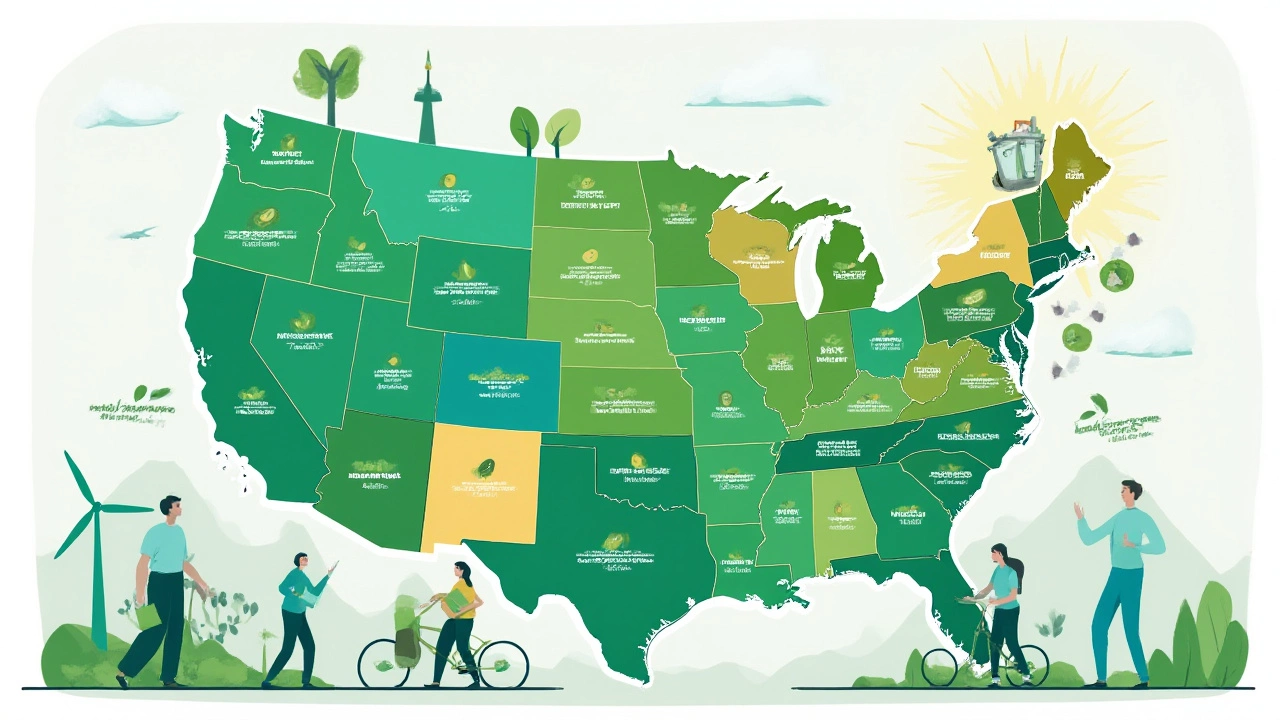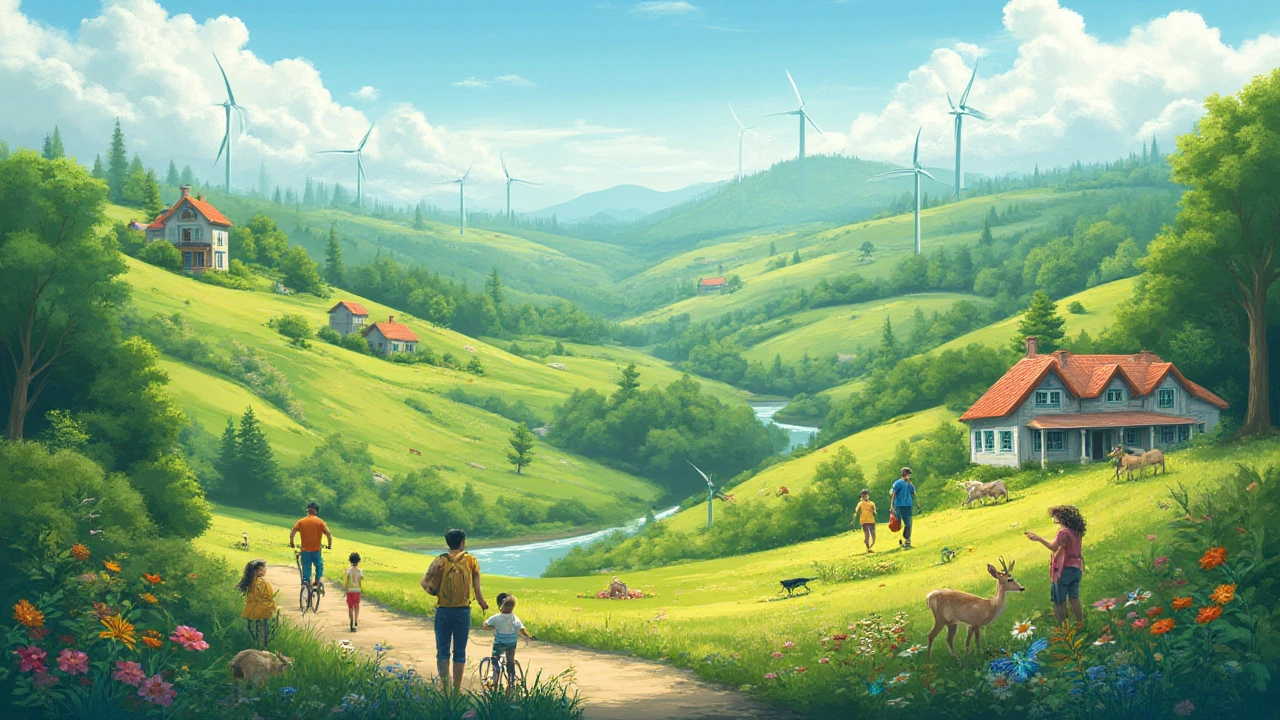So, did you ever wonder which corner of the U.S. is really crushing it when it comes to taking care of the environment? Some states tote their love for nature on their sleeves (or license plates), but when you peel back the stickers and slogans, things get seriously interesting. The data tells a story with big plot twists. Ready to find out if your state measures up—or if you need to start packing for a move to greener pastures?
The True Contenders: Who Claims the Top Spot?
When it comes to eco-friendliness, fierce competition brews between the northern pines of Vermont and the vast forests of Washington. These aren’t just pretty places filled with moose and evergreens; they're leading the charge on renewable energy, public transit, and recycling rates that frankly, make the rest of us look like we’re stuck in the 90s.
According to the 2024 WalletHub Greenest States ranking and the Yale Environmental Performance Index, Vermont consistently shows up near or at the top. It boasts an impressive blend of renewable electricity, the lowest carbon dioxide emissions per capita, and more organic farms per square mile than anywhere else in the country. For a bit of trivia—nearly 99% of Vermont’s electricity comes from renewable sources, mostly hydropower and wind. How’s that for commitment?
Washington isn’t far behind. Not only does it pump out clean hydroelectric power (nearly three-quarters of all its electricity!), it’s got city composting programs, miles of bicycle lanes, and a culture that treats recycling as a sacred duty. For the numbers nerds, Washington has over 16,000 megawatts of hydroelectric generating capacity—the highest in the nation.
Oregon makes up the third piece of this green triangle. It’s known for its spirited environmental politics, sprawling public transit, and deep devotion to protecting forests and wetlands. The entire Pacific Northwest, honestly, gives off serious earthy vibes—but Vermont often edges everyone out by a hair due to smaller population and tighter-knit policies.
What Makes a State Environmentally Friendly?
So, what’s the secret sauce? It’s a mix of clean energy production, eco-friendly laws, conservation, and how much people actually walk the eco-walk—think bike commuting rates, recycling habits, and even how many people eat organic. It boils down to how well a state reduces pollution, preserves ecosystems, and embraces renewable energy.
The Environmental Protection Agency (EPA) and groups like Sierra Club look at air and water quality, energy efficiency, waste recycling, and protected land area. For instance, states like Vermont and Oregon ban things like single-use plastic bags. Meanwhile, Washington runs serious school-based recycling programs and makes it easy to take transit instead of driving.
- Most environmentally friendly us state policy: Vermont’s bottle redemption program—getting 5 or 10 cents back for every returned can or bottle—has kept nearly half a billion containers out of landfills since 1973.
- Portland, Oregon, is often called the bike commuting capital. Over 6% of residents commute by bike, compared to a national average of about 0.5%.
- Washington has some of the nation’s strictest building codes for energy efficiency. Even my friend who’s not into eco stuff says it’s impossible to buy a new house there without LED everything and smart thermostats.
- Vermont’s state parks cover 7% of the whole state. That’s a lot of green for one tiny place!

The Numbers Game: Measuring Green by the Stats
Love a good stat? Me too. Numbers cut through the hype. The following table lines up some hard data highlighting what really puts these states ahead in the green race:
| State | % Renewable Electricity (2024) | Recycling Rate (%) | CO2 Emissions per Capita (tons) | % Population Using Public Transit | Protected Land (%) |
|---|---|---|---|---|---|
| Vermont | 99 | 67 | 1.1 | 4.5 | 7 |
| Washington | 74 | 50 | 2.3 | 7.2 | 9 |
| Oregon | 70 | 53 | 2.0 | 6.1 | 10 |
| California | 35 | 45 | 2.5 | 8.8 | 15 |
| New York | 28 | 61 | 2.1 | 10.4 | 11 |
Pretty striking, isn’t it? Vermont cleans up on renewables. California is impressive with huge chunks of protected land (think Sierra Nevada, Big Sur, and half the hiking Instagram), but falls short on electricity. New York leads the pack in public transit (hello, NYC subway), but has more work to do on renewables.
Surprising Underdogs and Room for Growth
You’d think sunny states like Florida or Arizona, with their endless sunshine, would lead the solar energy race. But policies and investment matter. Rooftop solar in California is massive, but in Florida? It lags, since utilities and regulators have made it a headache (even with all that sun). Policy can make or break a state’s green dreams.
Another surprise: states like New York and Massachusetts stand out not just for renewable energy or parks, but for disaster readiness. With wild weather becoming the new normal, these states have turned stormwater management and climate resilience into art forms. New York’s "green infrastructure"—think living rooftops and rain gardens—has exploded in cities from Buffalo to Brooklyn.
Meanwhile, Texas, the home of oil, has quietly become a wind power titan. It produces more wind energy than any other state. Go figure—sometimes the biggest pivots happen in places you’d never expect.
But let’s be real: every state, even the greenest, has a slice of humble pie to eat. Vermont’s biggest challenge? Transportation. Rural folks need cars, and electric vehicle infrastructure is still catching up. In Washington and Oregon, massive wildfires in 2023 and 2024 have shown that even green giants aren’t immune to climate risk. Adaptation is a moving target—no one has it totally nailed.

Simple Ways Anyone Can Pitch In—Green State or Not
So maybe you’re not in Vermont or Washington. That doesn’t mean you can’t channel their eco mojo. Believe me, change starts small, and states often take cues from their citizens. I started composting last summer (thanks to my spouse Damon’s nagging—okay, gentle reminders) and couldn’t believe how much less trash we sent to the curb. Here’s some hands-on advice anyone can use:
- Push for local recycling pickups—get neighbors together and ask your town council for better options.
- Try out a public transit route, even if it’s just once a week—you’ll be shocked at how much you save on fuel and stress.
- Swap grass lawns for native wildflowers or gardens. Way prettier, less mowing, and pollinators will love you.
- Sign up for green power with your utility if you can. More companies are offering wind or solar power buys right on your bill—sometimes just a few dollars extra per month.
- Use refill stations or bulk stores to cut down on plastic waste. I found a refill shop a few blocks away and now my family goes through maybe half as much plastic as before.
- Organize clothing swaps or buy secondhand. Seriously, the planet can only handle so many fast fashion hauls.
- Request that local restaurants or schools try Meatless Mondays or source food locally. Change starts with a single meal.
It always feels impossible until, suddenly, it’s normal. And when it comes from the ground up (literally and figuratively), leaders catch on. Do a little, inspire a neighbor, and suddenly your town or state could be on the next most environmentally friendly list.
If you don’t see your state up top, don’t sweat it. Most places have bright green spots and some rough edges. But if we all dig in—no matter where we are—maybe we’ll tip this whole country greener, one compost pile or solar panel at a time.
